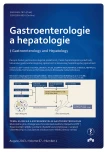Peroral endoscopic myotomy (POEM) for the treatment of a rare type III achalasia
Authors:
J. Krajčíová 1; R. Procházka 2; J. Pintová 2
; J. Špičák 1; J. Martínek 1
Authors‘ workplace:
Klinika hepatogastroenterologie, IKEM, Praha
1; Gastroenterologické oddělení, Nemocnice Jablonec nad Nisou
2
Published in:
Gastroent Hepatol 2013; 67(4): 261-263
Category:
Clinical and Experimental Gastroenterology: Case Report
Overview
Achalasia is a relatively rare motility disorder of the esophagus characterized by atypical or the absence of, peristalsis and a defective relaxation of the lower esophageal sphincter (LES). This results in impaired bolus transportation and stasis of food in the esophagus. Traditionally, achalasia had been classified as classic (aperistalsis) and vigorous achalasia (simultaneous contractions). At present, a new Chicago Classification of esophageal motility disorders has been introduced. According to this system, achalasia can be distinguished in three subtypes due to results of high-resolution manometry (HMR): type I – ‘classic type’ without peristalsis; type II – the most frequent type, with pressurisation of the esophageal body, and type III (rarest) – with spastic contractions. Type III is characterized by the worst results of different types of treatment, especially of endoscopic balloon dilatation. Etiology of the disease is still unknown and the aim of treatment is to relieve the functional obstruction at the level of LES (for example: balloon dilatation, Heller myotomy, or new peroral endoscopic myotomy – POEM). This case report describes a polymorbid patient with rare type III achalasia (the first diagnosed patient in the Czech Republic), who was successfully treated with the endoscopic technique – POEM.
Key words:
achalasia – high-resolution manometry – peroral endoscopic myotomy
The authors declare they have no potential conflicts of interest concerning drugs, products, or services used in the study.
The Editorial Board declares that the manuscript met the ICMJE „uniform requirements“ for biomedical papers.
Submitted:
12. 7. 2013
Accepted:
23. 7. 2013
Sources
1. Pandolfino JE, Kahrilas PJ. Presentation, diagnosis, and management of achalasia. Clin Gastroenterol Hepatol 2013; 11(8): 887–897.
2. Pandolfino JE, Kwiatek MA, Nealis T et al. Achalasia: a new clinically relevant classification by high-resolution manometry. Gastroenterology 2008; 135(5): 1526–1533.
3. Rohof WO, Salvador R, Annese V et al. Outcomes of treatment for achalasia depend on manometric subtype. Gastroenterology 2013; 144(4): 718–725.
4. Martínek J, Rösch T, Špičák J et al. První „POEM“ (perorální endoskopická myotomie) v České republice. Gastroent Hepatol 2012; 66(6): 475–476.
Labels
Paediatric gastroenterology Gastroenterology and hepatology SurgeryArticle was published in
Gastroenterology and Hepatology

2013 Issue 4
- Metamizole vs. Tramadol in Postoperative Analgesia
- Metamizole at a Glance and in Practice – Effective Non-Opioid Analgesic for All Ages
- Possibilities of Using Metamizole in the Treatment of Acute Primary Headaches
- Current Insights into the Antispasmodic and Analgesic Effects of Metamizole on the Gastrointestinal Tract
- Spasmolytic Effect of Metamizole
Most read in this issue
- Esophageal manometry
- Proton pump inhibitors: side effects and interaction
- Pentasa Sachet 2 g
- Peroral endoscopic myotomy (POEM) for the treatment of a rare type III achalasia
